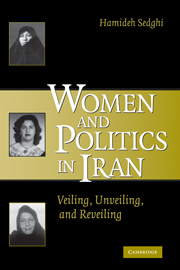Book contents
- Frontmatter
- Contents
- Acknowledgments
- Transliteration and References
- Introduction
- PART I WOMEN IN EARLY TWENTIETH-CENTURY IRAN
- PART II WOMEN IN THE KINGDOM OF THE PEACOCK THRONE
- PART III WOMEN IN THE ISLAMIC REPUBLIC OF IRAN
- 6 Women, the 1979 Revolution, and the Restructuring of Patriarchy
- 7 The Gender Division of Labor
- 8 Politics and Women's Resistance
- Conclusion
- Glossary
- Selected Bibliography
- Index
7 - The Gender Division of Labor
from PART III - WOMEN IN THE ISLAMIC REPUBLIC OF IRAN
Published online by Cambridge University Press: 22 August 2009
- Frontmatter
- Contents
- Acknowledgments
- Transliteration and References
- Introduction
- PART I WOMEN IN EARLY TWENTIETH-CENTURY IRAN
- PART II WOMEN IN THE KINGDOM OF THE PEACOCK THRONE
- PART III WOMEN IN THE ISLAMIC REPUBLIC OF IRAN
- 6 Women, the 1979 Revolution, and the Restructuring of Patriarchy
- 7 The Gender Division of Labor
- 8 Politics and Women's Resistance
- Conclusion
- Glossary
- Selected Bibliography
- Index
Summary
The Islamic regime views “women's work in the public sphere as incompatible with household responsibilities,” wrote Jaleh Shadi-Talab, a Tehran University sociologist. Its policies, Shahla Jelodarzadeh, the Sixth Majles deputy noted, “give preference to men's employment” and “family management to women.” Consistently criticized, Mitra Bagherian, a Plan and Budget economist indicated, “women are faulted for lack of compliance with the strict rules concerning head cover or overdress clothes, or even having a trace of cosmetics” and sometimes, are threatened with dismissal. This reflects governmental expectations on “the kind and the extent of the hejab at work which leave women contemptuous and cynical, if not rebellious.”
Despite earlier restrictions and harsh discriminatory policies that discouraged women's work outside the home, the post-war reconstruction policies and the introduction of economic liberalization induced more women to join the labor market. The number of women in private and public occupations grew, but the share of women in the labor force declined in comparison with the statistics of the late 1970s. Women also entered the educational system in large numbers, and by 2002, they constituted about 71 percent of university enrollments. Alarmed by this upward trend, some officials initiated in 2004, though unsuccessfully, a debate on a quota system to dissuade women from pursuing higher education. Although the Islamic regime preferred to keep women in the household, and initially, underreported their labor force participation in the census statistics, with their presence in the economy and the educational system, women have begun to pose indirect challenges to those political and social taboos that uphold motherhood and wifehood as women's primary and only responsibility.
- Type
- Chapter
- Information
- Women and Politics in IranVeiling, Unveiling, and Reveiling, pp. 221 - 244Publisher: Cambridge University PressPrint publication year: 2007



